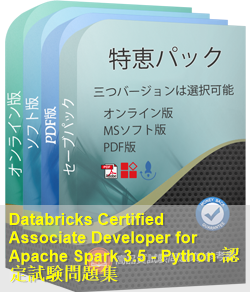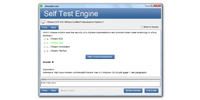JPNTestでDatabricks Associate-Developer-Apache-Spark-3.5問題集をチョイスする理由
JPNTestは、1週間で完璧に認定試験を準備することができる、忙しい受験者に最適な問題集を提供しております。 Associate-Developer-Apache-Spark-3.5の問題集は、Databricksの専門家チームがベンダーの推奨する授業要綱を深く分析して作成されました。弊社のAssociate-Developer-Apache-Spark-3.5学習材料を一回のみ使用するだけで、Databricks認証試験に合格することができます。
Associate-Developer-Apache-Spark-3.5はDatabricksの重要な認証であり、あなたの専門スキルを試す認定でもあります。受験者は、試験を通じて自分の能力を証明したいと考えています。 JPNTest Databricks Certified Associate Developer for Apache Spark 3.5 - Python は、Databricks Certificationの85の問題と回答を収集して作成しました。Databricks Certified Associate Developer for Apache Spark 3.5 - Pythonの知識ポイントをカバーし、候補者の能力を強化するように設計されています。 JPNTest Associate-Developer-Apache-Spark-3.5受験問題集を使用すると、Databricks Certified Associate Developer for Apache Spark 3.5 - Pythonに簡単に合格し、Databricks認定を取得して、Databricksとしてのキャリアをさらに歩むことができます。
ダウンロード可能なインタラクティブAssociate-Developer-Apache-Spark-3.5テストエンジン
Databricks Certificationの基礎準備資料問題集には、Databricks Certification Associate-Developer-Apache-Spark-3.5試験を受けるために必要なすべての材料が含まれています。詳細は、正確で論理的なものを作成するために業界の経験を常に使用しているDatabricks Certification によって研究と構成されています。
Associate-Developer-Apache-Spark-3.5試験の品質と価値
JPNTestのDatabricks Certification Associate-Developer-Apache-Spark-3.5模擬試験問題集は、認定された対象分野の専門家と公開された作成者のみを使用して、最高の技術精度標準に沿って作成されています。
Associate-Developer-Apache-Spark-3.5の迅速なアップデート対応
Associate-Developer-Apache-Spark-3.5試験に変更がございました場合は、現在の試験と一致するよう、瞬時に学習資料を更新することができます。弊社は、お客様に最高、最新のDatabricks Associate-Developer-Apache-Spark-3.5問題集を提供することに専念しています。なお、ご購入いただいた製品は365日間無料でアップデートされます。
あなたのAssociate-Developer-Apache-Spark-3.5試験合格を100%保証
JPNTestテスト問題集を初めて使用したときにDatabricks Certification Associate-Developer-Apache-Spark-3.5試験(Databricks Certified Associate Developer for Apache Spark 3.5 - Python)に合格されなかった場合は、購入料金を全額ご返金いたします。
Databricks Certified Associate Developer for Apache Spark 3.5 - Python 認定 Associate-Developer-Apache-Spark-3.5 試験問題:
1. Given a DataFramedfthat has 10 partitions, after running the code:
result = df.coalesce(20)
How many partitions will the result DataFrame have?
A) 20
B) 1
C) 10
D) Same number as the cluster executors
2. A data engineer wants to process a streaming DataFrame that receives sensor readings every second with columnssensor_id,temperature, andtimestamp. The engineer needs to calculate the average temperature for each sensor over the last 5 minutes while the data is streaming.
Which code implementation achieves the requirement?
Options from the images provided:
A) 
B) 
C) 
D) 
3. A data engineer wants to create an external table from a JSON file located at/data/input.jsonwith the following requirements:
Create an external table namedusers
Automatically infer schema
Merge records with differing schemas
Which code snippet should the engineer use?
Options:
A) CREATE EXTERNAL TABLE users USING json OPTIONS (path '/data/input.json')
B) CREATE EXTERNAL TABLE users USING json OPTIONS (path '/data/input.json', schemaMerge
'true')
C) CREATE EXTERNAL TABLE users USING json OPTIONS (path '/data/input.json', mergeSchema
'true')
D) CREATE TABLE users USING json OPTIONS (path '/data/input.json')
4. A data analyst wants to add a column date derived from a timestamp column.
Options:
A) dates_df.withColumn("date", f.unix_timestamp("timestamp")).show()
B) dates_df.withColumn("date", f.date_format("timestamp", "yyyy-MM-dd")).show()
C) dates_df.withColumn("date", f.from_unixtime("timestamp")).show()
D) dates_df.withColumn("date", f.to_date("timestamp")).show()
5. A data engineer is working ona Streaming DataFrame streaming_df with the given streaming data:
Which operation is supported with streaming_df?
A) streaming_df.orderBy("timestamp").limit(4)
B) streaming_df.groupby("Id").count()
C) streaming_df.select(countDistinct("Name"))
D) streaming_df.filter(col("count") < 30).show()
質問と回答:
| 質問 # 1 正解: C | 質問 # 2 正解: D | 質問 # 3 正解: C | 質問 # 4 正解: D | 質問 # 5 正解: B |


 448 お客様のコメント
448 お客様のコメント





